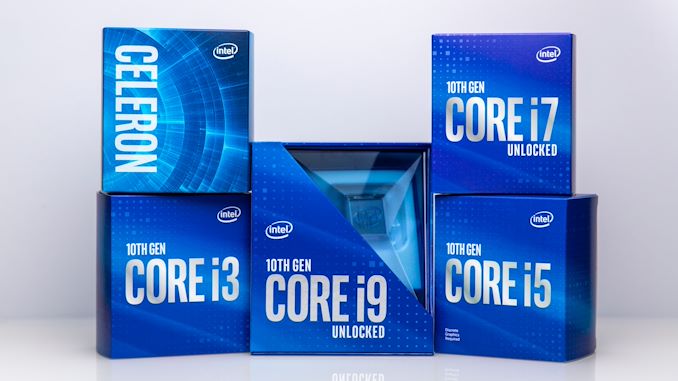Intel Confirms Rocket Lake on Desktop for Q1 2021, with PCIe 4.0
by Dr. Ian Cutress on October 7, 2020 12:00 PM EST- Posted in
- CPUs
- Intel
- PCIe 4.0
- Z490
- Rocket Lake

In a blog post on Medium today, Intel’s John Bonini has confirmed that the company will be launching its next-generation desktop platform in Q1 2021. This is confirmed as Rocket Lake, presumably under Intel’s 11th Gen Core branding, and will feature PCIe 4.0 support. After several months (and Z490 motherboards) mentioning Rocket Lake and PCIe 4.0 support, this note from Intel is the primary source that confirms it all.
The blog post doesn’t go into any further detail about Rocket Lake. From our side of the fence, we assume this is another 14nm processor, with questions as to whether it is built upon the same Skylake architecture as the previous five generations of 14nm, or is a back-port of Intel’s latest Cove microarchitecture designs. Add in PCIe 4.0 support rather than PCIe 3.0 - there’s no specific indication at this time that there will be an increase in PCIe lane counts from the CPU, although that has been an idea that has been floated. Some motherboards, such as the ASRock Z490 Aqua, seem to have been built with the idea of a PCIe 4.0 specific storage M.2 slot, which when in use makes the PCIe 3.0 slot no longer accessible.
It is notable in the blog that John Bonini (VP/GM for Intel’s Desktop/Workstation/Gaming) cites high processor frequencies as a key metric for high performance in games and popular applications, mentioning Intel’s various Turbo Boost technologies. In the same paragraph, he then cites overclocking Intel’s processors to 7 GHz, failing to mention that this sort of overclocking isn’t done for the sake of gaming or workflow. The blog post also seems to bounce between talking about enthusiast gamers on the bleeding edge and squeezing out every bit of performance at the top-end, to then mentioning casual gamers on mobile graphics; it’s comes across as erratic and a bit bipolar. Note that this blog post is also posted on Medium, rather than Intel’s own website, for whatever reason, and also seems to change font size mid-paragraph in the version we were sent.
The reason why this blog post is being today, in my opinion, is two-fold. Firstly, recent unconfirmed leaks regarding Intel’s roadmap has placed the next generation of desktop processor firmly into that Q1/Q2 crossover in 2021. By coming out and confirming a Q1 launch window, Intel is at least putting those rumors to bed. The second reason is down to what the competition is announcing: AMD has a Zen3 related presentation on October 8th, and so with Intel’s footnote, we at least know what’s going on with both team blue and team red.
Related Reading
- Best CPUs for Gaming: September 2020
- ASRock Z490 Aqua Motherboard Review: The $1100 LC Monoblock Flagship
- The Intel Comet Lake Core i9-10900K, i7-10700K, i5-10600K CPU Review: Skylake We Go Again
- The Intel Z490 Overview: 44+ Motherboards Examined
- AMD Announces Ryzen "Zen 3" and Radeon "RDNA2" Presentations for October: A New Journey Begins
Source: Intel










88 Comments
View All Comments
Spunjji - Saturday, October 10, 2020 - link
"Imagine being such a shill that you have to bend reality to fit your world view."Projection much? They said 10nm CPU with a TDP *over* 28W. If you're aware of such a thing (not counting the 50W boost, lol) then please do let us know.
eek2121 - Tuesday, October 13, 2020 - link
To add to this. TDP != power. There is not a single 15W chip that uses less than 30W of power for the duration of the benchmark suit. AMD included.Spunjji - Saturday, October 10, 2020 - link
"As if NVIDIA only released mobile GPUs for the 10-series, the 20-series, and the 30-series, and desktop users kept buying re-heated GTX 980 Ti GPUs."That's actually an excellent way of putting it.
eek2121 - Tuesday, October 13, 2020 - link
agreed.eek2121 - Tuesday, October 13, 2020 - link
Tiger Lake H is releasing in March, and (not so) amazingly, it will render anything below the Ryzen 5000 series, desktop or otherwise, obsolete. The issue is that now Intel has to contend with the 5000 series...however again they are in lockstep and neither has been able to pull away.Pneumothorax - Wednesday, October 7, 2020 - link
Wow another 14nm chip. I’m so excited. Intel in 2020 is IBM in 1986. While everyone was releasing 386 computers, IBM kept on releasing 286....edzieba - Wednesday, October 7, 2020 - link
Who cares what process node it's fabbed on if it delivers the performance you need for your application in the power budget you have available?baka_toroi - Wednesday, October 7, 2020 - link
No corporation can bend the law of physics. Process node is 100% relevant to a CPU's performance.JayNor - Wednesday, October 7, 2020 - link
smaller nodes can be lower power. Higher clock rates, not so predictable. AMD's Norrod says they may need to go to 3D fabrication to improve performance ... Rice HPC conference, 2019.TheinsanegamerN - Wednesday, October 7, 2020 - link
The 14nm node is obsolete at this point and will hold backw hatever proposed improvements Intel has made. Or will require a nuclear reactor style heatsink.